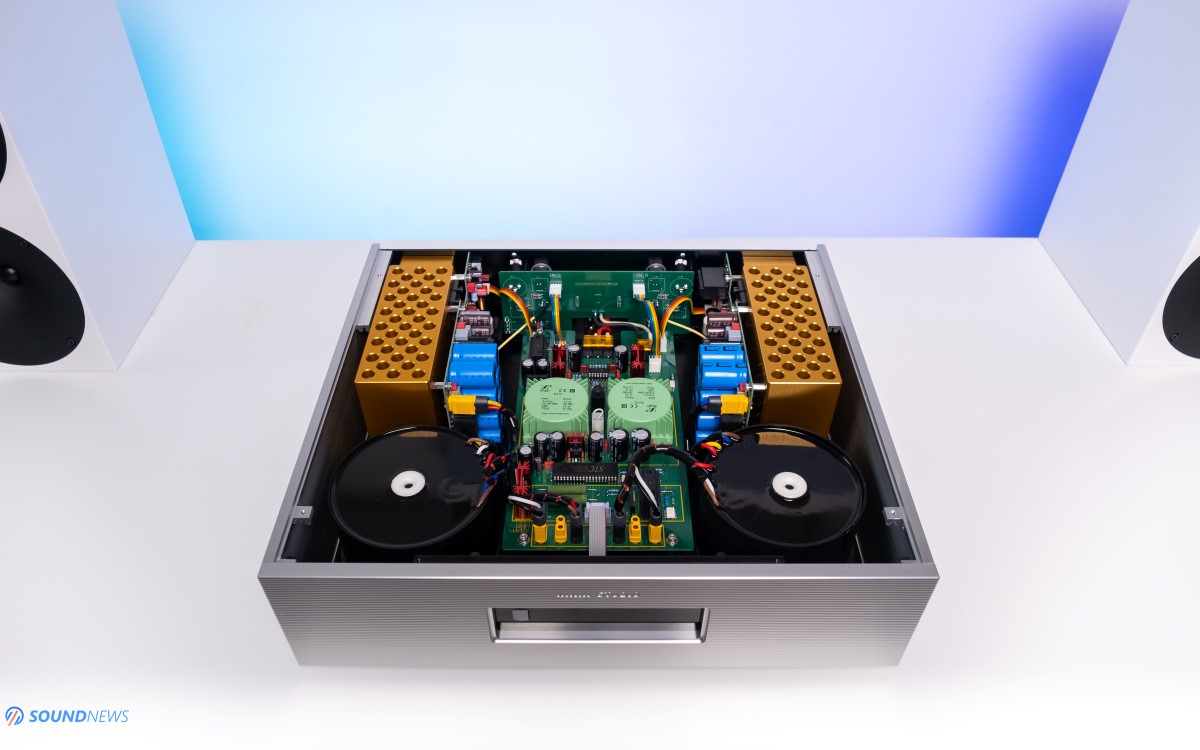Kinki Studio EX-M7 Power Amp Review – A Natural Bare-Knuckle Pugilist

My Video Review:
From the tens of audio manufacturers from the land of the Red Dragon that I came across, I can count about three of them which are really proud about their identity and achievements. Without a doubt, on top of this very short list stays the funky Kinki Studio team. With a simple but powerful message as “We Come From China” stamped on all their units and on the first page of their user manuals, it is clear that Kinki Studio is not kinky at all about their name or identity. Having a chin up, being honest and unique, believing in yourself is the only way to succeed. These are my ways of life that I follow and cherish and when I’m seeing other ones embracing those things, I need to mention them. Kinki is that kind of company and wish they will never change.
Kinki Studio is a relatively new team in the overgrowing landscape of audio manufacturers and in the latest two or so years, I’ve sensed a big push towards International markets with lots of written and video reviews popping here and there for this particular manufacturer. Kinki Studio is also a very positive thinking and quite a funny team as well. When I started my introduction to my Kinki Studio Vision THR-1 headphone amp review, my wife told that I had too many jokes in there and it might upset them. I published blindly both my reviews and I’ve got back only tons of laughs and positive vibes from the team.
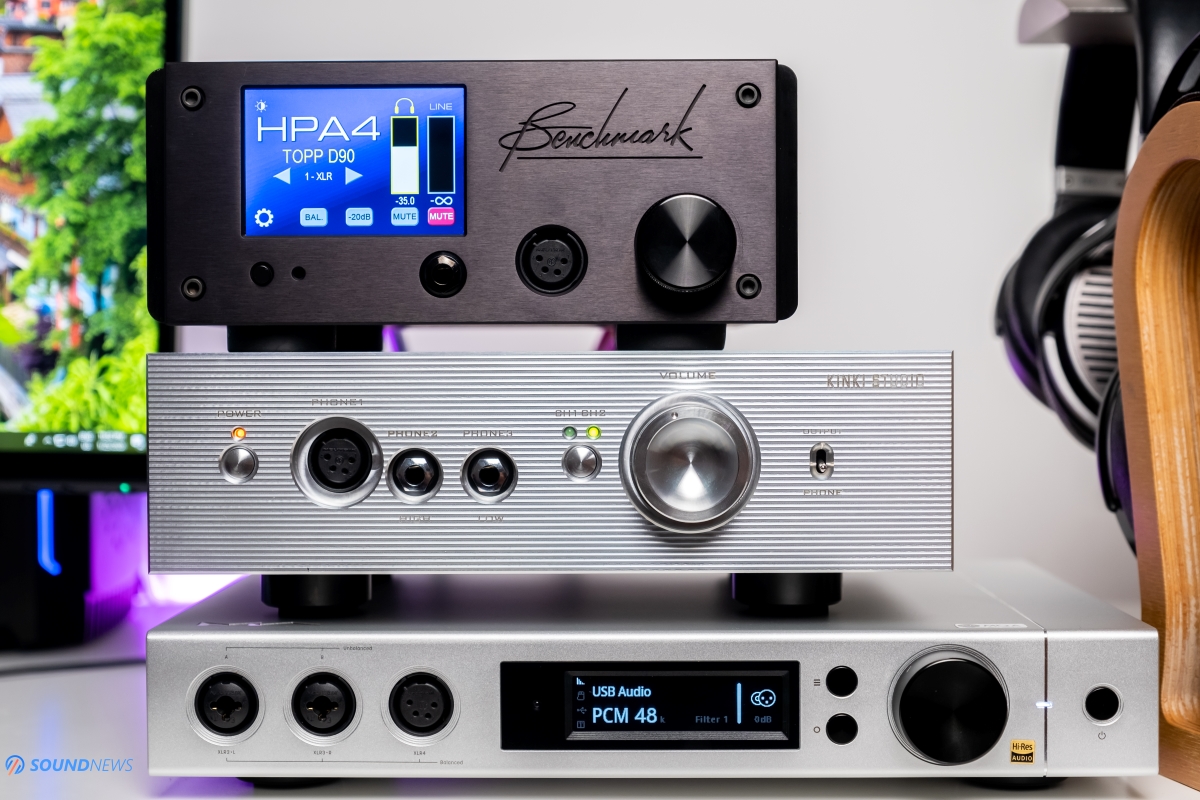
THR-1 was one of the most powerful headphone amps I’ve tested at that time and one of the most natural sounding one as well. When I’ve sent back the loaner unit, I wished I could borrow that naturalness and plant it inside the Benchmark HPA4 that I am using daily. You can’t eat your cake and have it too, right?
Fast forward a few months, I was giving a difficult task of testing their newest and freshly released EX-M7 (M7 from now on) power amplifier. Difficult? Hah! I was screaming inside with joy as I never tested anything from their EX (Extreme Series) line of products, so it will come more as a pleasure and not as a task to finish.
Not going to lie, that this is my first DC-coupled, ultra-wide-band 0 Hz to 2.5 MHz power amplifier I have tested to date, with a stunning Signal to Noise ratio of 130 dB (A-Weighted) and with a whopping 400 Watts of instantaneous power into 8 Ohms, EX-M7 got some really interesting stuff going on the inside, so let’s check it out in a very Soundnews (read: in-depth) way.
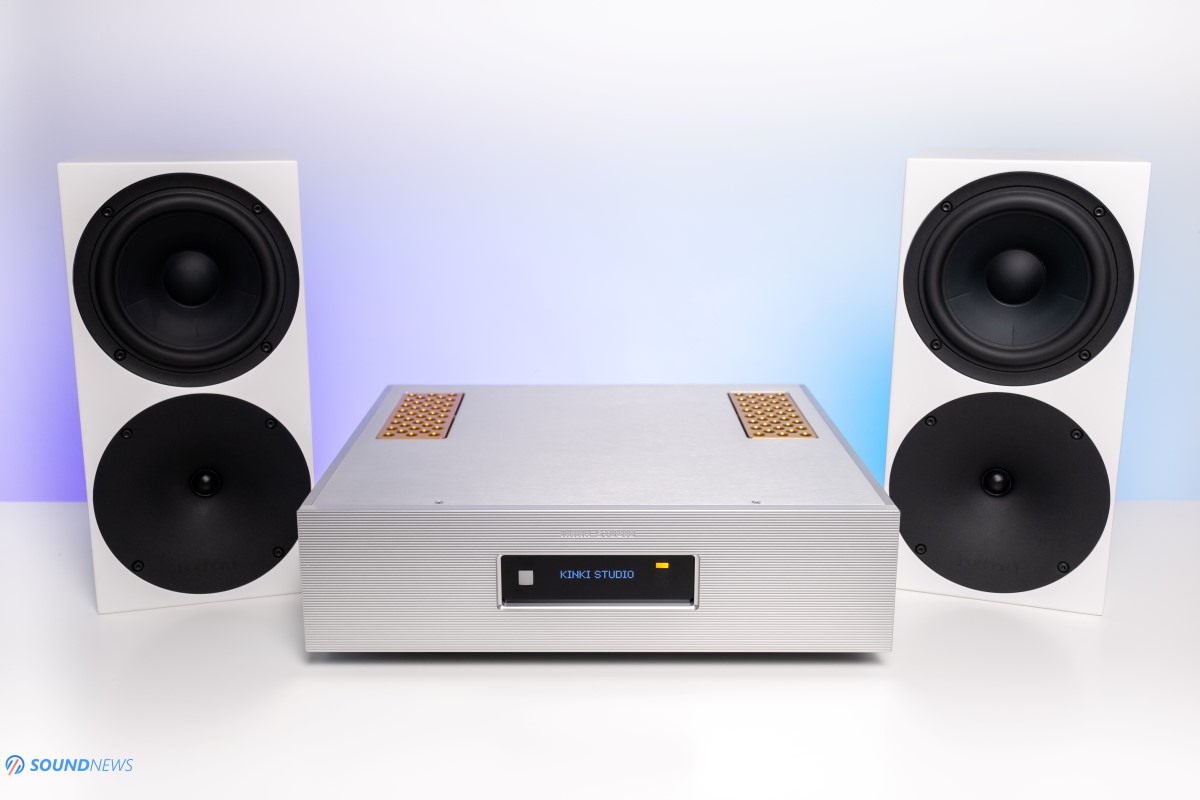
Unboxing a Beast
I’ve received a lot of big boxes but the one for M7 was the mothership or all card-board boxes I’ve got so far. Hegel H190, Keces S125, Audio-GD R7 or Denafrips Venus boxes suddenly felt tiny and really meaningless by comparison. It was not only extremely large but heavy weight as well; I already knew that a beast is dwelling deep inside that box. M7 came double boxed and the product box was filled with an unhealthy amount of extra-foam for protection. This loaner unit did a long way towards me and the outer box had a few bumps in the corners, but luckily the smaller box looked absolutely intact. Inside it you will find only the power amp itself, a simple instruction manual and a power cable. As with all power amplifiers, nothing more is really needed to put it to hard work.
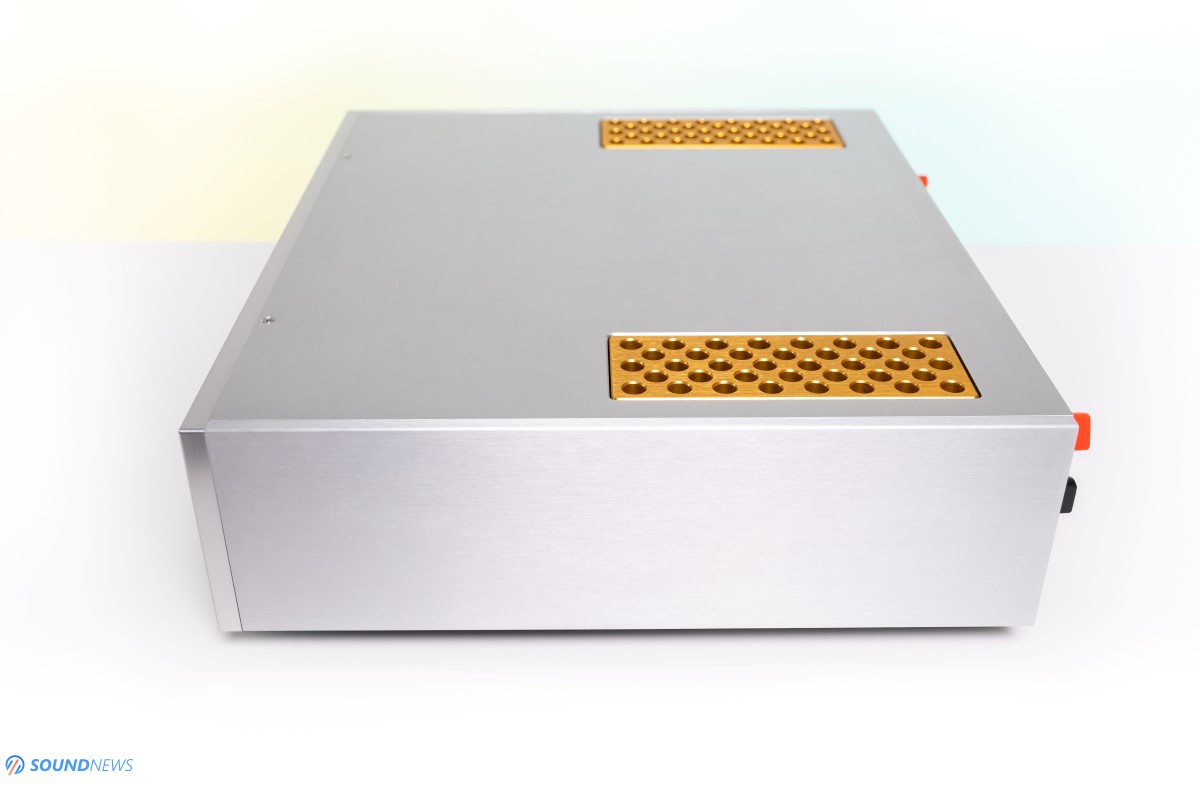
Design & Build Quality
M7 is simply build like a tank with very thick front and lateral panels and I had absolutely the same first impression about the Kinki THR-1 when I first saw and touched it. Any wireless interference should not affect its performance even in a very revealing system. The front panel has a thickness of about 11 mm and left and right panels a thickness of 8 mm. As for the size, it is simply massive and it dwarfed every single integrated or power amplifier I used to this date. I used to think that my Cambridge Azur 851A was big and Keces S125 power amp is pretty big too. What a joke. M7 is considerably larger than any of those and it is much heavier too. I could barely fit it on a shelf in my speaker setup and in all honesty, I probably need a proper Hi-Fi rack for a much better ventilation and heat dissipation. Oh, about that, I never saw such a clever and proper way of dealing with heat. See those gold painted perforated aluminum blocks? The holes on them will go completely through the amplifier and the air that passes through them will cool down that extremely powerful output stage. I’ve seen lateral heatsinks, internal heatsinks, using the whole case as a massive heatsink, but drilling holes so that air could move freely in and out and heat would go away instantly, that is some clever thinking from the Kinki Studio team. I’m impressed.
The cool approach, literally and figuratively doesn’t stop here. Kinki Studio designed their M7 as a modular and easy to service device. They actually prepared a complete guide for their M7, with it you can troubleshoot any issues you might have with this one. In case something goes bad, it can be serviced at home without the need of a highly skilled professional. An amp board went bad? Simply replace it with another one using only home tools. How cool is that?
Weighting some serious 25 kilos or slightly more than 55 pounds, some heavy-duty metal feet would be needed to support all this weight and this is exactly what Kinki Studio did. I really don’t see a point of replacing such beautiful machined metal feet with other ones, it would be pointless…unless you fancy those Gold Viablue QTC spikes to match with the Gold cooling aluminum blocks of M7. That would look classy.
To me, M7 looks like a massive block of aluminum, it screams high quality craftsmanship and I wish more companies from China would adopt such high-quality standards. It looks more industrial than refined to me, with straight lines and bold looks. Forget about WAF, it is out of the window with this one, it is simply too big, way too imposing and if you are planning on getting one, stretch your budget and get a nice gift to your lady as well.
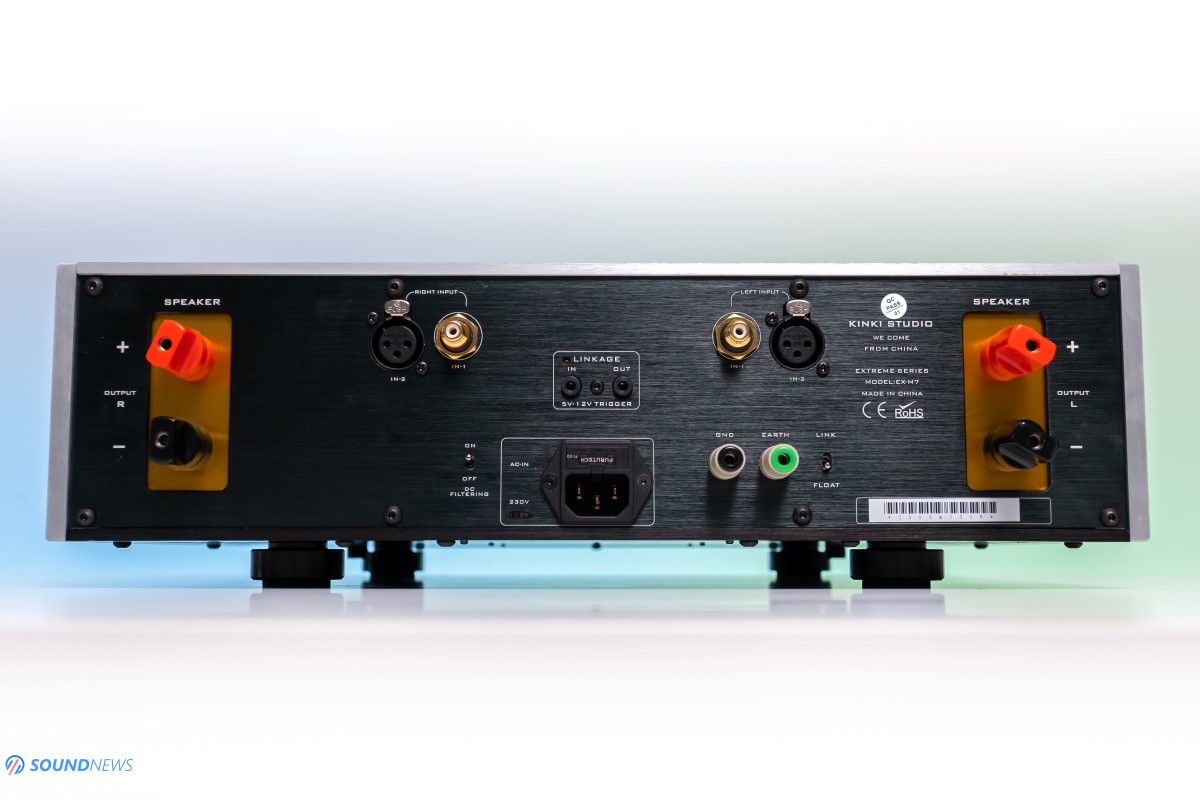
Controls & Connectivity
This is where Kinki Studio impressed me again and let me explain you why. I personally know few close friends that are using passive power conditioners with their stereo equipment, only because they have polluted AC lines in their apartments. Without them, they’ll hear only buzzes and hums, completely ruining the listening experience. Kinki decided to incorporate a filtering circuit inside this unit that will remove noise from your power lines. By default, I recommend leaving it at Off position and only if you hear any disturbing hisses, just pop the switch up and you’ll enable the DC filtering, chasing away all those nasty creatures.
If you want to further level-up your listening experience, M7 is also equipped with an Earth / Ground optimization circuit that could further improve your music listening. They also added a Link / Float switch that will enable or disable the power earth with the chassis. You can connect the Earth and/or Ground to the upstream equipment or you can connect the Earth / Ground terminal to the ground box and see for yourself if there is an improvement or not.
Besides all this clever wizardry, you can spot the left and right speaker terminals, the balanced XLR and unbalanced RCA inputs, a high-quality fused Furutech AC inlet and a pair of triggers that can work with the rest of Kinki Studio gear, just in case you’ll want to power them On or Off with a single remote.
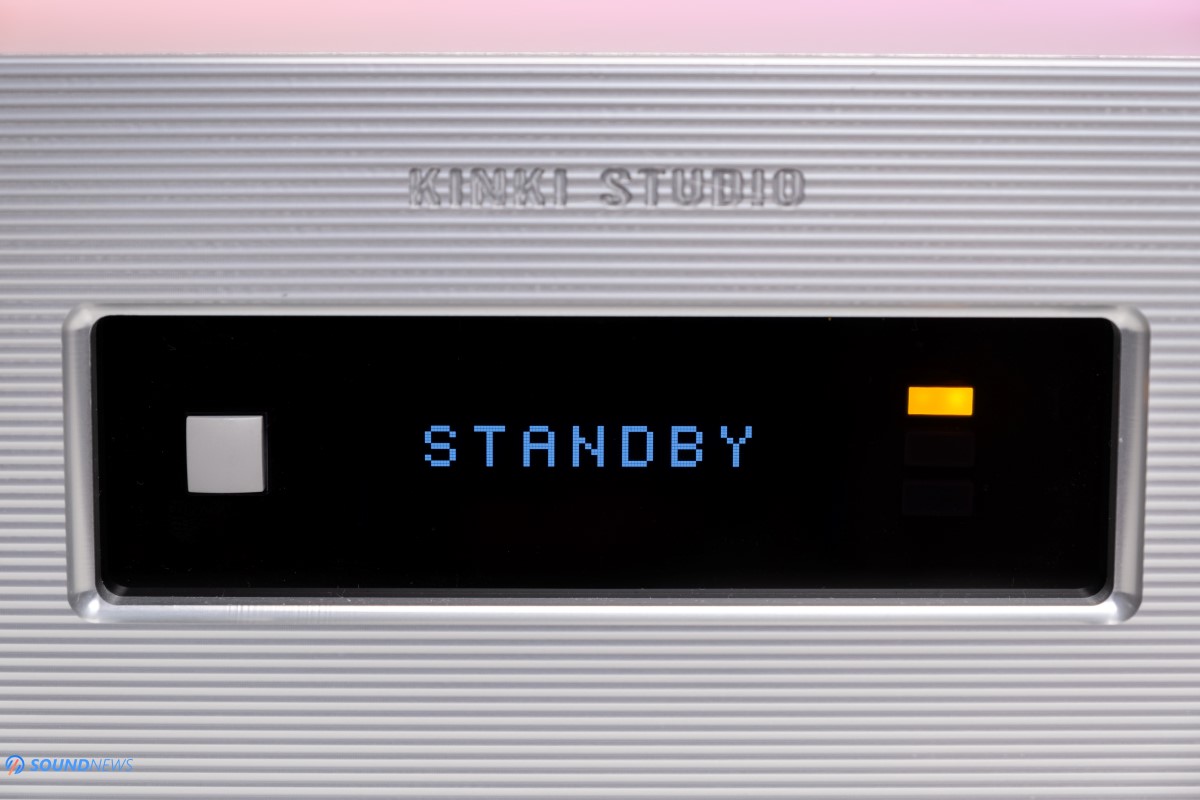

On its front plate, there is only a simple On/Off button and a large OLED screen in the middle. The OLED screen will be engaged only for few seconds when you power it On or Off, otherwise three low-intensity LEDs will show its working status: Green light – working in normal conditions, Yellow light – stand-by mode is engaged and Red light means it detected an error and it powered itself Off.
When I moved to our home, I’ve completely rebuilt the electric AC lines, with high-quality OCC wiring, adding a simple yet effective passive conditioner. Only my office and the living room is wired to that passive conditioner. In my particular case, the DC filter switch isn’t doing anything at all, as I am experiencing a buzz and hum-free performance with the DC filtering disengaged, but that can be a different story in your listening room. I recommend experimenting with and without DC filtering and the same can be said about Ground and Earth terminals.
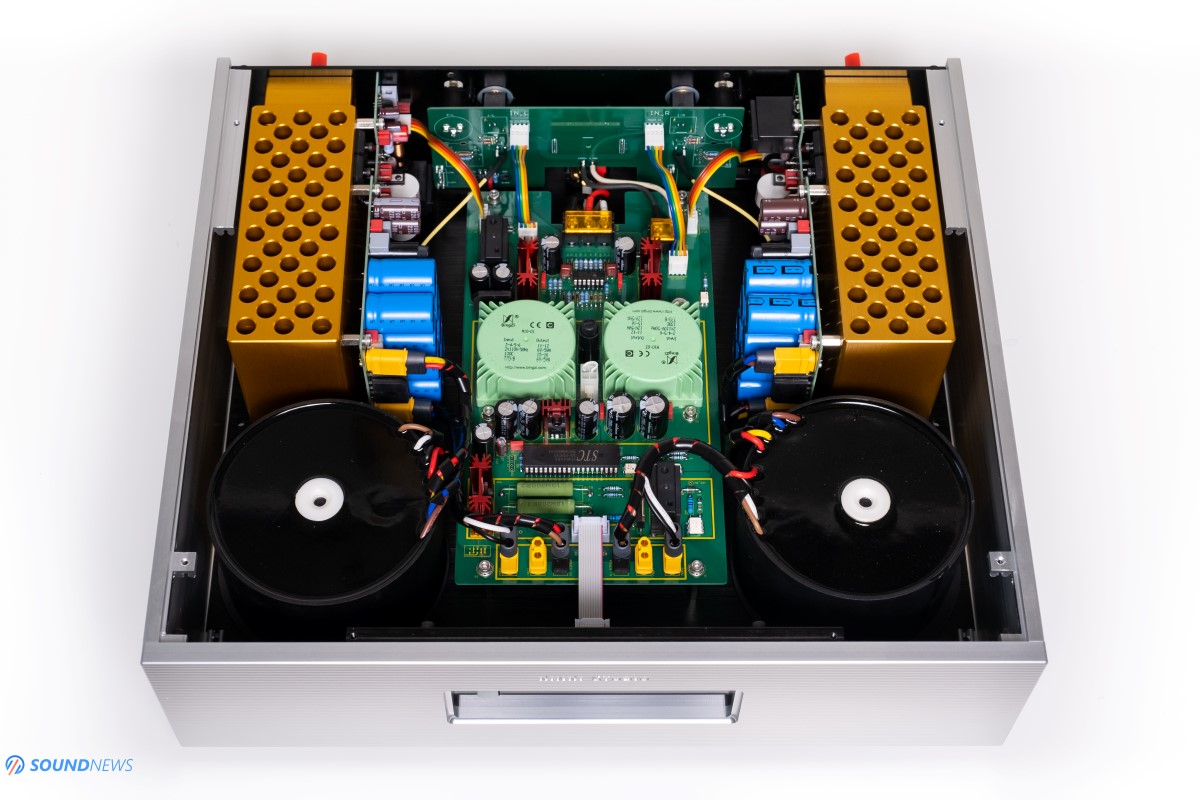
Technology inside EX-M7
As I said it before, M7 is a direct DC coupled power amplifier, meaning that it doesn’t have a single capacitor in the signal path, all the caps you see are used only for power filtering or for storing power for high dynamic swings. You should know that M7 is working in Class-AB, meaning that is consumes a lot of power, offers a lot of power in return and dissipates a lot of heat as well.
With a direct DC coupled design, offering a continuous power of 250W into 8 Ohms, 420W into 4 Ohms and almost double that number for some instantaneous dynamic swings, should result an ultra-fast response time, some world-class dynamics and an amazing transient response without affecting refinement or the detail and the transparency of the sound.
M7 is drawing power from two oversized and encapsulated 400VA toroidal transformers that can provide up to 72 Volts DC and 18 A peak current! I’m sorry, but all my past power amplifiers and integrated ones are sitting numb and silently in a corner. In terms of specs, the big guy simply outperformed them all.
The incredible spec sheet doesn’t stop here: 4 Exicon mosfets are driving the output stage – these are among the best you could possibly have, there are also 4 output transistors per channel (8 in total) that should provide an instant power delivery to your loudspeakers, some high-performance Mundorf caps for power filtering, 8 incredibly large blue caps per channel for storing DC power, another 2 smaller toroidal transformers, I see some juicy and oversized ceramic resistors, and the list goes on and on.
M7 will consume 30W at idle and 700 W at max output, so its clear that it knows how to move those speaker drivers, or should I say pound those drivers with an unstoppable force. Another great thing that I spotted much later on is the lower input sensitivity of 1.45 Vrms, meaning that it will work nice with low and high-voltage preamplifiers and volume shouldn’t be an issue with low output devices such as portable DAPs or entry level DACs with volume control.
Kinki Studio equipped this unit with a speaker protection circuit and in an event of mis-operation or malfunction of the speakers, the protection circuit will immediately shut-down the amplifier to protect it and the speakers from further damage.
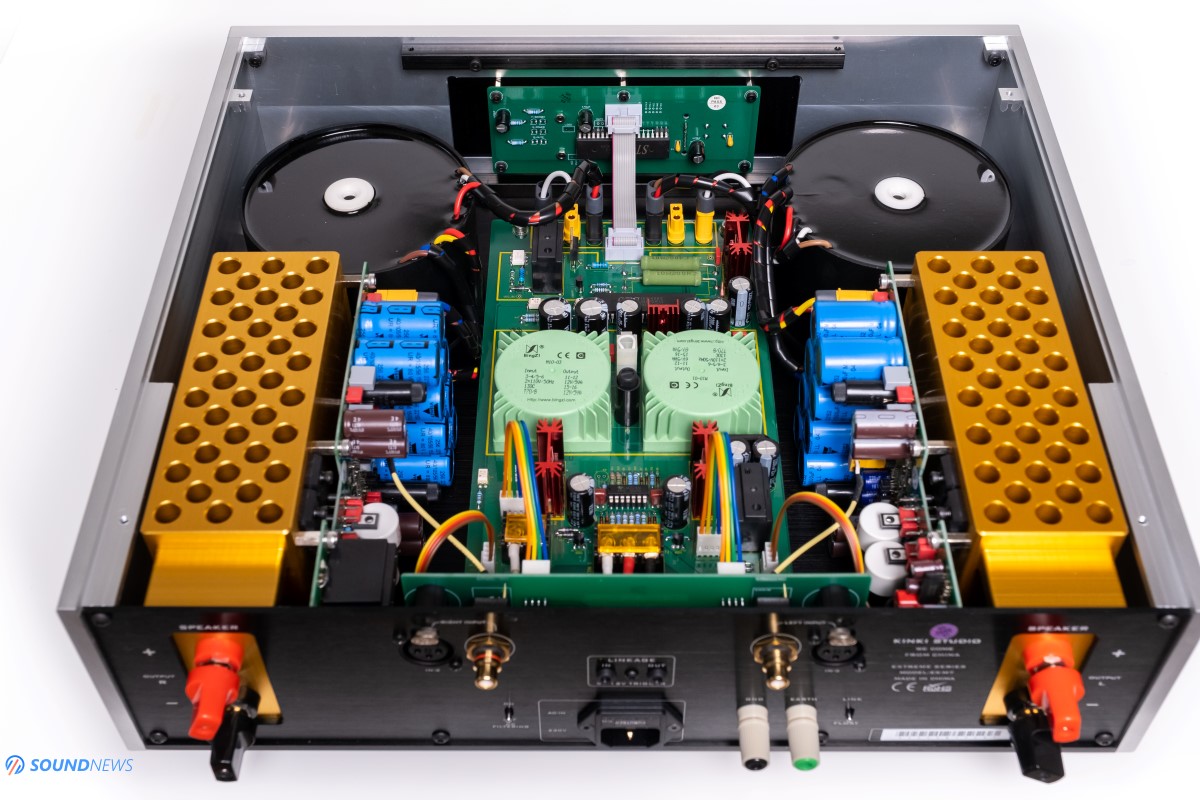
Test Equipment
Since the Audiobyte HydraVox is still making rounds among few of my friends, I used the Matrix Audio Element X as the streamer and DAC to squeeze the last bit of performance out of EX-M7. Element X already incorporates a hybrid analog/digital preamp section so I connected it directly to the Kinki unit. Later on, I also added the Benchmark HPA4 as a dedicated preamp in my system to see If I can further improve the listening experience. I used the Buchardt S400 loudspeakers with them and sincerely EX-M7 may be an overkill power amp for speakers of this size. With all that said, if you ever listened to some premium speakers from Denmark like Dynaudio or Buchardt, you would know that those can really scale with a powerful amplifier that could offer an instant power delivery.
Ok everyone, it is time to have a proper listen to the Big Boy.
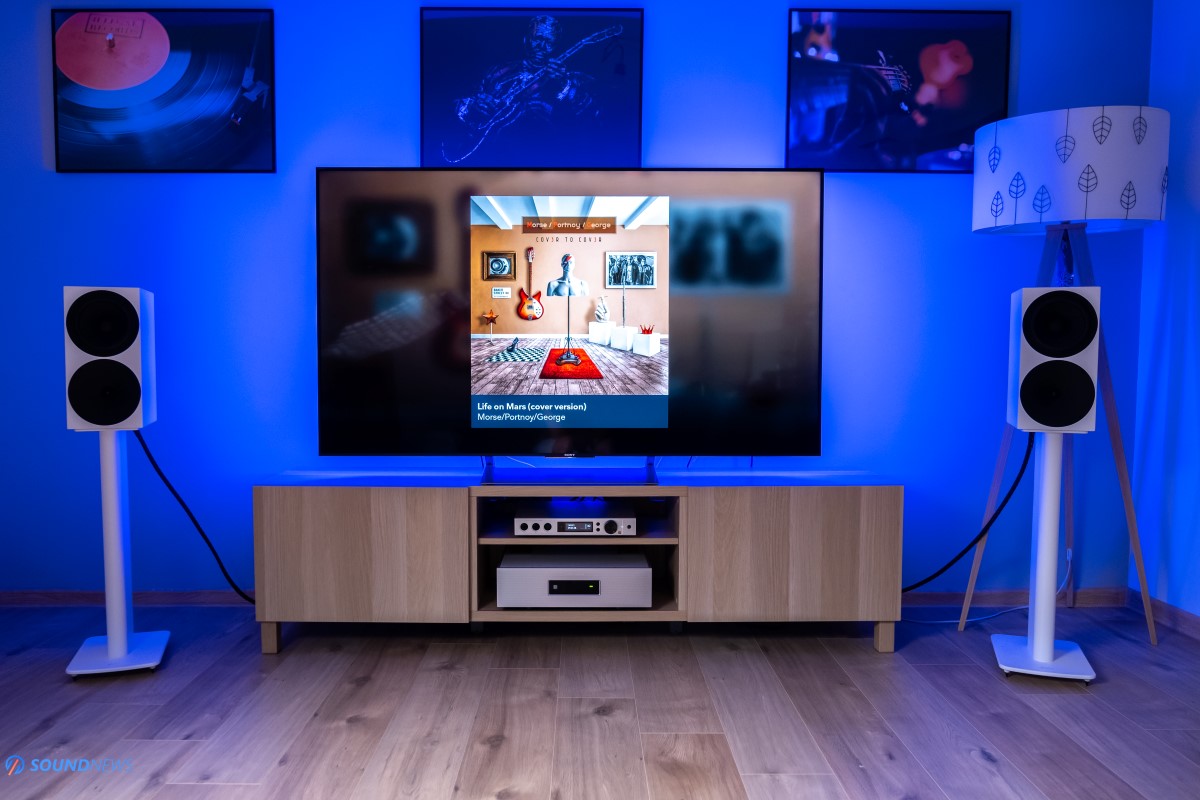
Sound Performance
I. Preliminary Impressions
I was quite happy unboxing and connecting it to everything, then suddenly out of the blue I get an email informing me that at least 300 hours of burn-in is recommended for it to shine bright in a stereo setup. I was actually expecting that. With so many capacitors, 4 toroidal transformers, fresh transistors and mosfets, I knew that at least 2 painful weeks of burn-in will be needed to unleash the full potential of this unit. Easier said than done, as every single day I would pass by the living room, I would sit for few minutes and would listen to whatever my Tidal playlist would play in that particular day. I think in the 3-rd day my rock playlist started playing and somewhere at noon Tidal finished it and started playing some recommended tracks. The shock came when Points of Authority by Linkin Park (Tidal / Spotify) started playing (I know, don’t judge). The bass impact on the 00:19, 00:25, 00:35 and 00:40 marks was simply out of this world. I don’t mean that it was simply going down low in a very detailed manner, I mean the pure raw impact and kick in the bass that M7 created was unheard off.
Do note that S400 has a huge passive radiator on back, yes, it’s passive and according to its creator, it eats watts for breakfast with fast energetic music. This is precisely why S400 sounded super snappy only with juicy power amplifiers and more than decent with integrated amplifiers. Even at day three, I knew that in terms of sheer bass slam – that is simply the most difficult thing to achieve in any amplifier, M7 was simply the best I’ve experienced thus far with the normal sized Buchardt S400. I’ve already mentioned in their dedicated review that a Hegel H190 and then a Keces S125 were doing sweet love with them awakening some impressive dynamics in the process, but M7 felt like going all-in and deep with the Buchardt’s. It pounded so hard, that I ran back to the office, I engaged my headphone setup which I knew is world class in terms of bass (Audeze LCD-4 and Kennerton Magni driven by the Benchmark HPA4) and to my surprise, the sheer kick and slam into my eardrums was considerably lower than what I’ve heard on the tiny S400 driven by that goliath of an amplifier. Even at its third day, I was ready to say that M7 is most probably an overkill power amplifier for the likes of S400, but that doesn’t mean Buchardt’s didn’t scale, because they really did and what a pleasant surprise for a transient response nut as myself.
The following days, M7 did change a bit, I wouldn’t say it went from the bright to the dark side or vice-versa, because that would not be true, but the biggest change was felt in terms of speed and in terms of smoothness or liquidity. Its tonality was already great from the first day.
Oh, speaking about its tonality, it is important to say that I have experienced Exicon mosfets only in their THR-1 headphone amplifier that had this bold, heavy tonality with a big impact in the bass and midrange area, being slightly shy and mellow in the treble area. THR-1 was heavy sounding and slightly blunt in terms of speed, because I always wanted just a little bit more attack. Compared to that one (apples to oranges, really), EX-M7 doesn’t stutter at all, it is as nimble and as fast as the best I’ve experienced thus far. I will go as far and say that after 2 weeks of burn-in, passing the recommended 300 burn-in time, M7 is really all about speed, about kick and impact, about naturalness, it has a perfect bass and midrange performance, with a grain-free approach to treble reproduction.
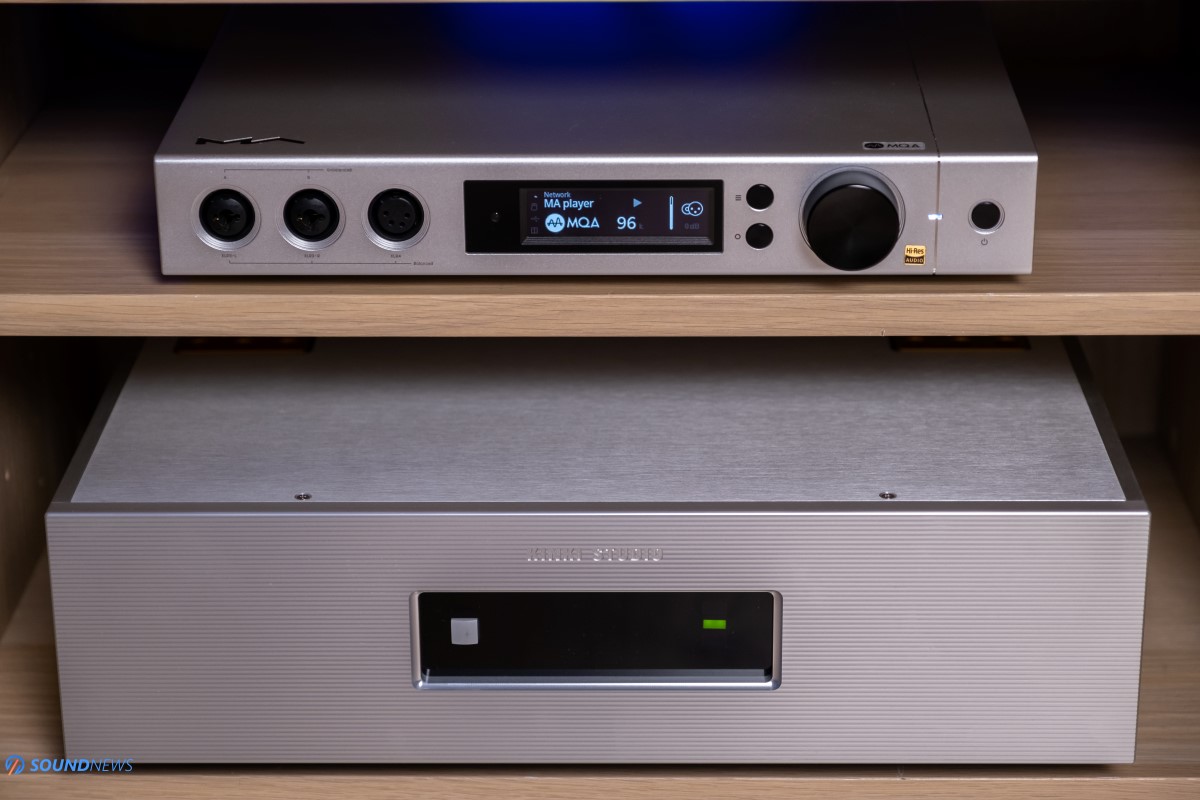
II. Noise Floor
Before talking about noise floor, you should know that Matrix Element X is already a very serious stopping force for anything that has to do with digital jitter. There wasn’t a day, when I’ve experienced dirty and muddy background with this unit, so I’m pretty sure it already cleans up that nasty noise, hiss or hum. Another thing to add is that when I’m using its internal streamer, USB connection goes out of the discussion, so again the jitter that might come from a noisy PC is nowhere to be found. Lastly, the costly power lines that I implemented at my place really cleaned up the mess I had before that, especially in my office everything sounds crystal clear and engaging from morning till dawn. Even without the Benchmark HPA4 in the chain, Element X + M7 was simply an amazing match and even at very high volumes, I couldn’t spot a dirty background. I went as far as approaching the speakers at an angle so I could preserve my hearing and I cranked the volume a bit higher than usual. I was 22 dB away until unity gain of 0 dB (max volume) and still, S400 sounded clean, without a trace of distortion or disturbing noise.
Even with that DC Filtering set to Off position, sound was crystal clear and dark as night. In the past I’ve experienced multiple power amps that were raising distortion at higher volumes, but with such a high-performance power filtering inside this unit and a lot of power to spare, M7 is simply free of any noise at any volume position.
S400 are both quite sensitive for low-level listening and are also very demanding if you are rising that volume up. Luckily, M7 was both a gentleman and a hard rocker with these speakers, depending on the volume and music that is being played.
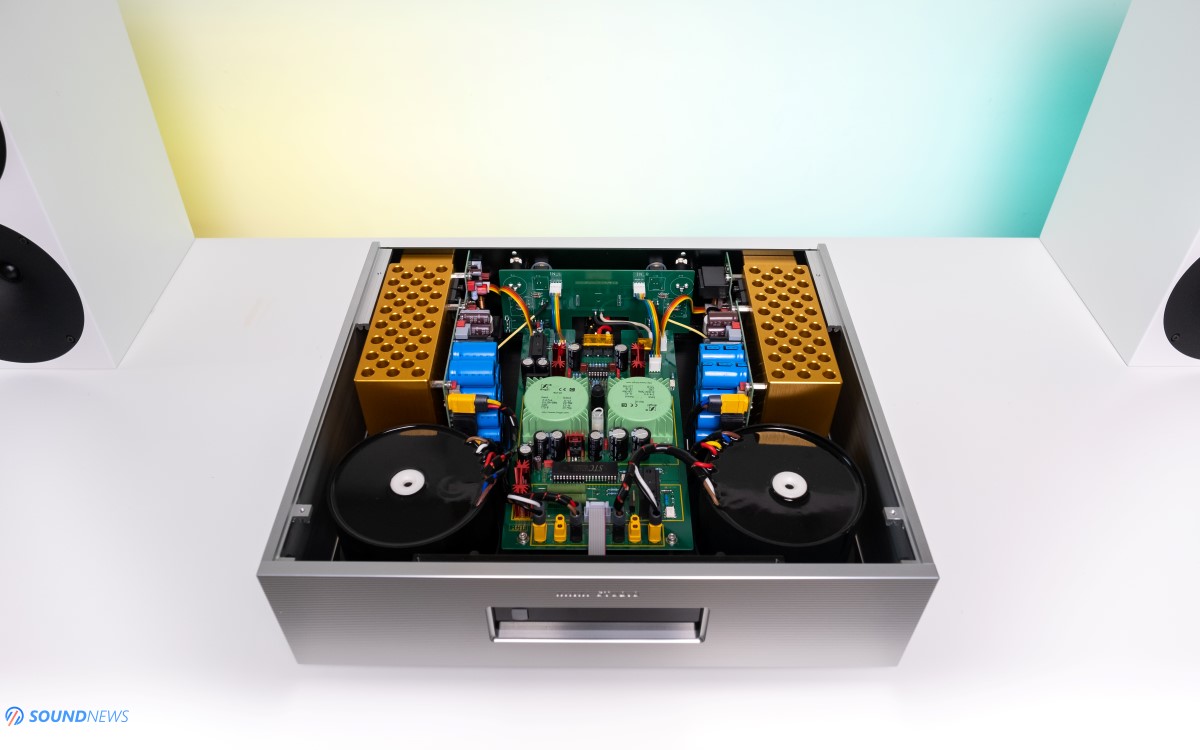
III. Transient Response
As always, this is my favorite chapter in all my reviews as it directly influences the mood of the listener and has a major impact on slam/kick, speed and decay of all musical notes. When I was testing the Flux Lab Acoustics FCN-10 I’ve felt a very strong correlation between output power and transient response. At the same listening volume of 90 dB (measured with the MiniDSP EARS) between several amplifiers, I felt a much bigger enjoyment factor with the FCN-10 compared to the rest because it simply had double the power compared to the rest and pushed those dynamics high and down much faster compared to the rest. My ears started waving as I never experienced such a slam in a headphone-based setup.
With EX-M7, I’m feeling a Deja-Vu in here as it is twice as powerful compared to KECES S125 power amp and about 6 times more powerful to the KECES E40 that I still have somewhere around. As you might expect, EX-M7 outperformed the rest of the gang and provided the best transient response of the bunch. I’m refraining from using big words in here, but in all honesty, EX-M7 is simply the definition of fast transient response. Once fully burnt-in, expect a lighting quick speed and punch into the chest that will be felt for quite some time.
Wife even spotted me hand banging and toe tapping wildly on some Eric Clapton featuring BB.King – Riding With The King (Tidal / Spotify), usually I would do that on considerably faster, louder and meaner music. Even listening to smooth and relaxing music like that, M7 will speed up the presentation and will dial up that kick and slam to eleven. The guitar plucks felt simply more visceral, drums considerably harder hitting, voice of the King was going deeper and lower in tonality, I was moved, literally.
When I decided to up my game by listening to some electronic music as Infected Mushroom – More Than Just A Name (Tidal / Spotify), I couldn’t hold my excitement level anymore as positive energy spiked into the sky. I looked at the speakers, yep it is still Buchardt S400, but the scale of the music was unrecognizable with notes jumping off the wall, bumping directly into my body, that was quite an experience that I will not forget. I simply couldn’t hold still with this kind of performance, as I believe M7 possesses one of the best pace, rhythm and timing I’ve experience thus far.
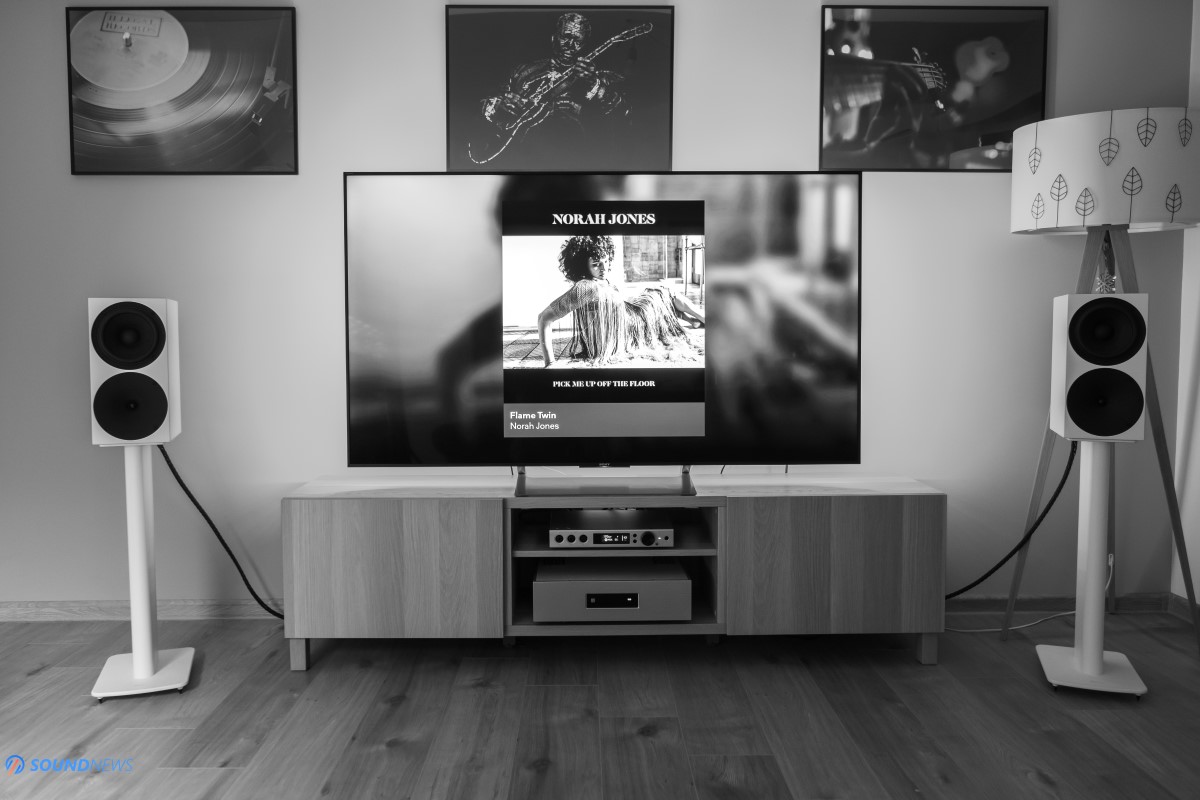
IV. Resolution & Transparency
Compared to my past integrated and power amplifiers, M7 simply has the highest signal to noise ratio of 130 dB! (A-weighted) meaning that when I’m listening to it, I’m sure that music is coming towards me in its purest form possible without too many things staying in its way. Well, except for the room acoustics that will always have something to say, add or remove from your listening experience. In a flat you can’t really go past 95 dB of volume, that is already too loud for comfortable listening. I consider that noise is triple-checked with this one and it never goes out of control.
Going through a huge music collection, covering a wide range of musical genres, I can safely say that M7 chooses to have a see-through transparency and a pretty high resolution even past top-octave. Did I hear few additional micro-details compared to a Hegel H190, Keces S125, E40 and to smaller power amps as Burson Bang and SMSL-DA8S? Sure, I did and all that was presented in a very relaxed (read: non-aggressive) way. I particularly liked that the top-end while being extremely textured and clean, was never bothering with brightness or dryness. There is not point of me going through a few songs just to arrive at the same conclusion. M7 is a clean and transparent sounding amplifier. For a Class-AB amp that is a little bit unusual, but considering the oversized power supply and filtering, it actually sounds as clean and transparent as the best Class-D amplifiers I’ve tried in the past as Expert Pro from Devialet.
I particularly liked that M7 while being extremely clean and detailed, it never forces you to look at those details. Snare drum hits and cymbal crashes stood out particularly with their natural metallic sounds but without the shrillness that few particular amps are having.
I am not really sure what secret sauce Kinki Studio poured over this one, because it sounds considerably clearer than the their THR-1 headphone amplifier, that still had a very thin veil over the music that was being played. THR-1 had a considerably lower signal to noise ratio and is not part of their EX (Extreme Series) so that makes perfect sense now.

V. Soundstage & Depth
I’ve always felt that a really snappy sounding amplifier that pushes a bigger amount of air, will sound considerably airier and larger on all axes. I mean it shouldn’t be a surprise to anyone that a big power reserve and good diaphragm control should have a huge positive impact on the stage size. I wish I could tone down a bit my enthusiasm level for this unit, but there is no other way in saying it that M7 is an open-sounding amplifier. It is not shy at all when it comes to scale and depth and no matter the song I played; it was always spot on in terms of stage size. Here are just few examples.
I started listening to the newest album of Ronan Keating – Twenty Twenty (Tidal / Spotify) and even starting with the first song I’ve heard a really spread out presentation with sounds coming from multiple angles towards me. It almost felt like I was watching a Dolby Atmos movie in a multi-speaker setup. Buchardt S400 are not really recommended in bigger rooms, but in my larger 35 square meter room, EX-M7 was able to fill-in all the gaps with music. I’ve felt again a denser and heavier tonality, I was simply surrounded by music in a very natural way. Little Thing Called Love plays with imagination in a well-thought speaker setup, as some of the notes are jumping from left to right and vice versa. The note placement in the room is spot on and I can easily appreciate the distance between each instrument. The voice that is sometimes playing on different tonalities felt guttural and full of substance and the initial sigh of the singer felt going deep into this song.
Newest album of Seasick Steve – Love & Peace (Tidal / Spotify) while is not a true reference recording, with a bit of grain and noise in the background, actually impressed me quite a lot in terms of depth. I literally felt that the recording room was bigger in size and everything was simply flying farther away before hitting a wall. The more I listened, the more I was distracted a bit by the background noise of this album, but when everything started rising in dynamics, I starting analyzing depth information and stage size with ease.
M7 is easily showing the increase or decrease of the air mass in the recording studio and if I’m engaging live-records then I simply cannot spot the imaginary walls with notes flying away to the abyss, fading away slowly and peacefully. Case in point, Hotel California (2013 Remaster) by Eagles (Tidal / Spotify) can still be considered a reference recording in testing out the stage size, note placement in the room and depth information. With songs of this caliber, I put my pen down, a grabbed a glass of aged whisky and forgot about writing anything. Such a goose bumping and relaxing experience. M7 shined brighter with this recording and again was showing a massive increase in transparency, stage size and depth. M7 was really made for music like this. I was simply amazed and mesmerized and I was ready for more.
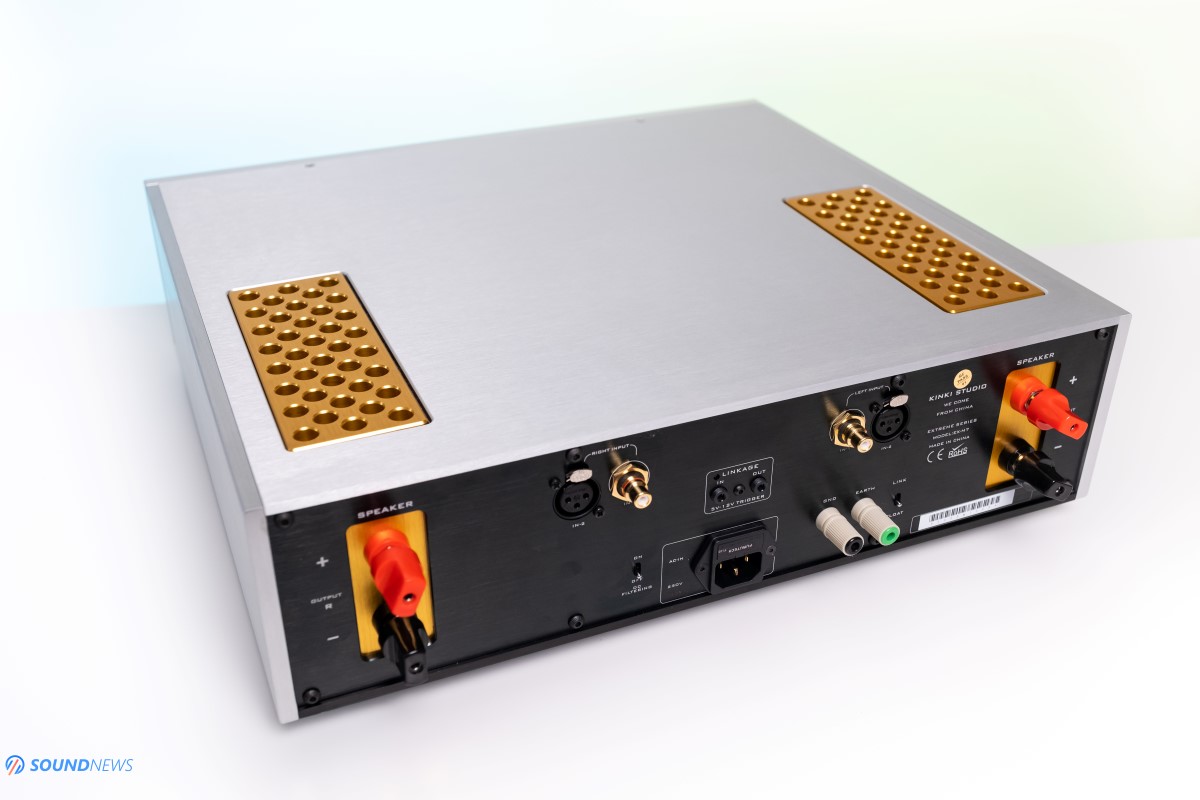
VI. Frequency Response
At this point I started swapping back and forth few amplifiers so that I could have at least a comparison later on and this is where the biggest difference was felt immediately that is simply called: Bass (1)
What a change, I couldn’t believe that S400 is able to awake such notes with its passive radiator on the back. I never heard them as alive and as hard hitting, especially in the bass it was something to behold. I’m comfortable saying that in terms of bass, starting with the lowest octaves and finishing with upper bass, M7 is having a perfect blend of impact, control and sustain. Could you wish for more in an amplifier? I don’t think so. Bass is still the hardest frequency to move, to sustain and decay naturally and this is where M7 is actually shining with its robust output stage. If you love bass and everything that has to do with it, M7 got you covered. It is not a bass-heavy amplifier, it is not boosting it at all, it is still a linear bass performance, but the sheer impact and kick needs to be heard to be believed. I’m hooked to this kind of bass performance. The funny thing is that I started spotting bass-notes where I never believed I can find them.
Midrange (2) felt simply natural, considerably denser compared to my former amplifiers, it was full of substance and while simply walking around the listening room you can feel the air heavier somehow. M7 is at the opposite pole to most Class-D amplifiers, without a single trace of dryness, thinness or harshness. I particularly enjoyed instrumental music with this one, where I felt the musical notes more visceral, more real and more soul-grabbing. It’s quite difficult explaining with words the exact feelings I had, but I will just say that I was carried away by music.
You could say that there was a small increase of midrange presence with this one, as all voices, string instruments and pipes felt more vivid and alive, pushing more air around and increasing the overall mood of the listener.
Treble (3) is another interesting aspect that I want to cover. First of all, the treble intensity was not lowered at all, there is still plenty of information even past top octave (16 KHz) and I can spot that easily even with less than perfect recordings. It is really interesting the way M7 chooses to render all that treble information. It does it in a relaxed and non-aggressive way, the contour/outline of every note is not extremely sharp and outlined and as such, it doesn’t point its fingers towards this region. Treble felt always having a natural texture and carried a decent amount of sharpness and leading edges. If I want better leading edges and sharper textures, I can simply add the Benchmark HPA4 in the chain working as a preamp that will do exactly that. I don’t know why, but with this particular setup, I liked my music without the HPA4 in the audio chain.
I also want to add, that EX-M7 is quite sensitive to gear swap, change the DAC or the preamp and that will be immediately reflected in the sound reproduction, can’t say much about the cable swaps as I am not a cable nut at all.
All in all, I felt a really good tonal balance and M7 offered a perfect dose of naturalness, midrange presence, bass authority and lots of micro-details in the treble. I wish more amplifiers would strike such a nice balance between being technical and natural sounding at the same time.

VII. A Comparison
I will say it from the start that price wise, at this moment I don’t have a power or integrated amplifier that is in the same ball-park. Hegel H190 at $4000 is considerably costlier, sadly I returned back the loaner unit few days ago. I am unable to make a direct comparison to that one, but I had it for a couple of weeks at my place and I’ve formed a solid opinion about that one. Even without having it at my side, I can say that I was moved considerably more by the Kinki EX-M7 performance with its almost flawless presentation. H190 was really good too, but I always wanted a little bit more. I wanted more body slam, a wider frequency response and a better micro-detail retrieval. As a power amplifier only, M7 was better at all key points including power, driver control and refinement. However, please consider that Hegel unit has also a dedicated DAC section, a powerful streamer and it’s a full blown integrated amplifier, meaning it has a preamp section too. Feature wise, H190 is hands down a much better all-in-one device and sound wise, EX-M7 felt like a much better amp on all fronts.
The only unit that has a chance versus M7 is the KECES S125 power amplifier that I am using for quite some time, so here goes nothing.
Kinki Studio EX-M7 (MSRP $2598) VS KECES S125 (MSRP $1400)
Both are power amplifiers only, both are working in Class-AB mode, however the very first watts of S125 will be delivered in Class-A. S125 is considerably smaller in size and offers less power output as well. As its name suggests S125 will offer 125W in 8 Ohm and M7 will double that number to 250W. S125 is considerably simpler inside, it is relying on a single 1000VA toroidal transformer, compared to 4 toroids on M7 (2 bigger and 2 smaller ones). M7 is also using two pairs of high-performance Exicon mosfets. For power filtering and storing, M7 is again taking the lead with a lot more of them. So even at this point, it is clear that M7 is a much higher-class device as all its internal components, weight, size and price are suggesting.
In terms of features, EX-M7 again outperformed the smaller fellow by offering DC filtering, GND and Earth posts, Link and Float possibility and most importantly an amplifier/speaker protection circuit which is vital in an expensive setup. In its defense, if you add another S125 to the chain, they can work together as a team in dual-mono mode offering some juicy 360 Watts of power in 8 Ohms.
In terms of overall tonality and frequency response, both are more alike than different going for a natural approach to music reproduction. They both excel in terms of bass and midrange presence with a slight difference than S125 felt less extended in the treble region. In terms of sheer power, control and punch, M7 is simply better and no matter the music is being played, it always wanted to impress myself by throwing better dynamics and more air around every note. Yes, more air, meaning better depth and wider soundstage size. Even with such small speakers, the difference was there and it was undeniable and easy to spot. Would I be happy with a just a S125? Yes, of course, it is still my daily driver and I love it to bits, but when it comes to ultimate performance, that trophy is for the M7 to take.
Another key point that was felt much later on is the detail and transparency. With higher quality recordings, there was simply a bit more of everything, slightly more bass layers, more guttural voices, clearer guitar plucks, more string vibrations and a much better treble performance. M7 felt more transparent and also offered a higher degree of micro-details.
I’m sure that in a less revealing system, the difference would be much smaller and of course in a more revealing system with harder to drive speakers, the difference would be considerably bigger, so it obviously depends on your particular setup.
All in all, Kinki Studio EX-M7 felt as a clear upgrade to my beloved Keces S125 and it has very big chances of becoming my new daily driver in the very near future.

Conclusion
There were a lot of green flags raised with M7 even from the start. The component selection was top notch, it had impressive specs top to bottom, particularly the output power, signal to noise ratio, its wide bandwidth and slew rates stood out from the rest. Not going to lie that I was very anxious to receive it and make a proper evaluation for this unit, it simply deserved my full attention.
As for its sound, it felt like pouring Trappist Belgian ale down my throat. It offered a fresh new sound, a much denser and full-bodied presentation, a powerful kick into my chest, a very spread-out soundstage plus an organic and like-life performance that I didn’t experience up to this point.
The attack and body slams that I’ve experienced with this one, would not be forgotten very soon as transient response, for me, is the most important aspect of any integrated or power amplifier.
Kinki Studio EX-M7 is quite an expensive power amplifier, coming at close to $2600, not a lot of folks could a afford such a unit. However, if you are searching for a top-class power amplifier that got power to spare, plus refinement in the same chassis, then EX-M7 is wholeheartedly recommended!
This is actually the second component ever to received our highest Gold Award. I am putting my reputation in this badge as I know that if you get one, lots of smiles, toe taps, head-bangs, whisky and Belgian ale bottles will follow.
Kinki Studio EX-M7 was kindly loaned to me by the Kinki Studio team, you can get one by following this link and if you do so, please say hello to Ken from me.

PROS:
- Big, bold, imposing, simple industrial design
- Impressive number of features, considering it is only a power amplifier
- Need lots of power? EX-M7 got that covered and it should drive easily stand-floors with the same authority and self-confidence.
- By far one of the best dynamics and body slams I have encountered in my speaker setup, EX-M7 is simply a natural pugilist.
- One of the best diaphragm controls, with an instant start and stop of the speaker drivers, has a speedy decay of the notes too.
- Sounds big, airy, decompressed and very deep. In terms of scale, this is the one to beat in all my future tests.
- Accurate pin point location of all musical notes, it is very 3D sounding.
- Extended frequency response at both ends, it’s linear and straight as a line too
- One of the best bass and midrange performance I’ve experienced thus far
- No background noise even at high listening volumes
- Great tonal balance, it sounds natural, life-like and organic
- That amp/speaker protection circuit is a god-sent
- If you want one of the best ones, this is it
CONS:
- Hot after about an hour or so, don’t place anything on top or under it. Few cm/inches will be needed for a proper ventilation
- Slightly bigger in size compared to all my former integrated and power amps, choose a proper rack that supports its size and weight
- A bit expensive but it’s understandable why
ASSOCIATED EQUIPMENT:
- DACs: Matrix Audio Element X, Audiobyte HydraVox, Flux Lab Acoustics FCN-10, Denafrips Venus, Burson Conductor 3X Performance
- Integrated Amps: KECES E40, Hegel H190 (now gone)
- Power Amps: Kinki Studio EX-M7, KECES S125
- Loudspeakers: Buchardt S400
- Headphone Amps: SparkoS Labs Aries, Benchmark HPA4, Flux Lab Acoustics FCN-10, Burson Conductor 3X Performance
- IEMs: FiiO FA9, FH7, Meze Rai Penta, Rai Solo & some lower tiered ones
- Portable headphones: Sennheiser Momentum 2, Meze 99 Classics
- Full-sized headphones: Audeze LCD-4, Erzetich Phobos, Hifiman Arya, Quad ERA-1, Kennerton Magni, Kennerton Gjallarhorn
- Interconnects: QED Reference (x2), Aune AL3
- Speaker cables: Kimber PR8, Audioquest Type4
- Power Cables: Isotek EVO3 Premier (x3)
- Balanced Isolation Power Conditioners: PLiXiR Elite BAC400, KECES BP-600
